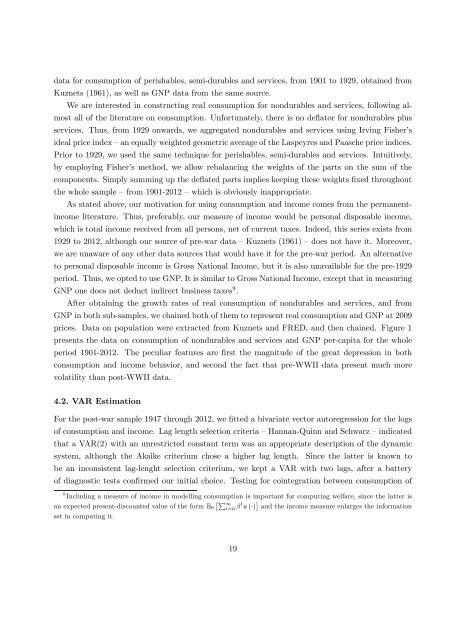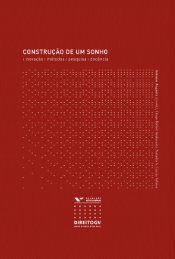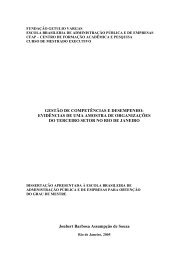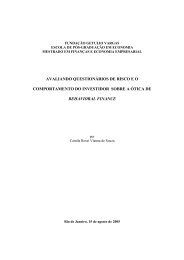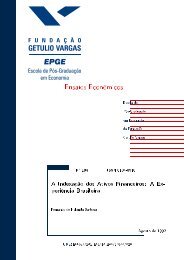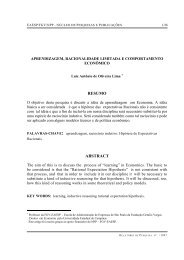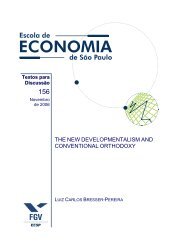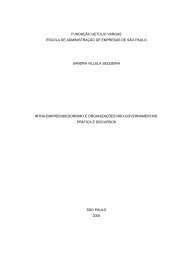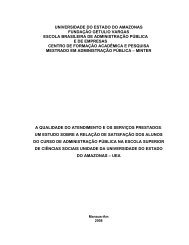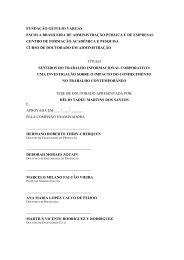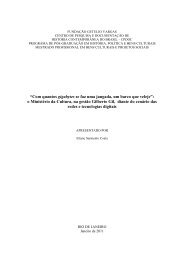Ensaios Econômicos - Sistema de Bibliotecas da FGV - Fundação ...
Ensaios Econômicos - Sistema de Bibliotecas da FGV - Fundação ...
Ensaios Econômicos - Sistema de Bibliotecas da FGV - Fundação ...
Create successful ePaper yourself
Turn your PDF publications into a flip-book with our unique Google optimized e-Paper software.
<strong>da</strong>ta for consumption of perishables, semi-durables and services, from 1901 to 1929, obtained from<br />
Kuznets (1961), as well as GNP <strong>da</strong>ta from the same source.<br />
We are interested in constructing real consumption for nondurables and services, following almost<br />
all of the literature on consumption. Unfortunately, there is no <strong>de</strong>‡ator for nondurables plus<br />
services. Thus, from 1929 onwards, we aggregated nondurables and services using Irving Fisher’s<br />
i<strong>de</strong>al price in<strong>de</strong>x –an equally weighted geometric average of the Laspeyres and Paasche price indices.<br />
Prior to 1929, we used the same technique for perishables, semi-durables and services. Intuitively,<br />
by employing Fisher’s method, we allow rebalancing the weights of the parts on the sum of the<br />
components. Simply summing up the <strong>de</strong>‡ated parts implies keeping these weights …xed throughout<br />
the whole sample –from 1901-2012 –which is obviously inappropriate.<br />
As stated above, our motivation for using consumption and income comes from the permanentincome<br />
literature. Thus, preferably, our measure of income would be personal disposable income,<br />
which is total income received from all persons, net of current taxes. In<strong>de</strong>ed, this series exists from<br />
1929 to 2012, although our source of pre-war <strong>da</strong>ta –Kuznets (1961) –does not have it. Moreover,<br />
we are unaware of any other <strong>da</strong>ta sources that would have it for the pre-war period. An alternative<br />
to personal disposable income is Gross National Income, but it is also unavailable for the pre-1929<br />
period. Thus, we opted to use GNP. It is similar to Gross National Income, except that in measuring<br />
GNP one does not <strong>de</strong>duct indirect business taxes 9 .<br />
After obtaining the growth rates of real consumption of nondurables and services, and from<br />
GNP in both sub-samples, we chained both of them to represent real consumption and GNP at 2009<br />
prices. Data on population were extracted from Kuznets and FRED, and then chained. Figure 1<br />
presents the <strong>da</strong>ta on consumption of nondurables and services and GNP per-capita for the whole<br />
period 1901-2012. The peculiar features are …rst the magnitu<strong>de</strong> of the great <strong>de</strong>pression in both<br />
consumption and income behavior, and second the fact that pre-WWII <strong>da</strong>ta present much more<br />
volatility than post-WWII <strong>da</strong>ta.<br />
4.2. VAR Estimation<br />
For the post-war sample 1947 through 2012, we …tted a bivariate vector autoregression for the logs<br />
of consumption and income. Lag length selection criteria –Hannan-Quinn and Schwarz –indicated<br />
that a VAR(2) with an unrestricted constant term was an appropriate <strong>de</strong>scription of the dynamic<br />
system, although the Akaike criterium chose a higher lag length. Since the latter is known to<br />
be an inconsistent lag-lenght selection criterium, we kept a VAR with two lags, after a battery<br />
of diagnostic tests con…rmed our initial choice. Testing for cointegration between consumption of<br />
9 Including a measure of income in mo<strong>de</strong>lling consumption is important for computing welfare, since the latter is<br />
P<br />
an expected present-discounted value of the form E 1<br />
0 t=0 t u () and the income measure enlarges the information<br />
set in computing it.<br />
19


